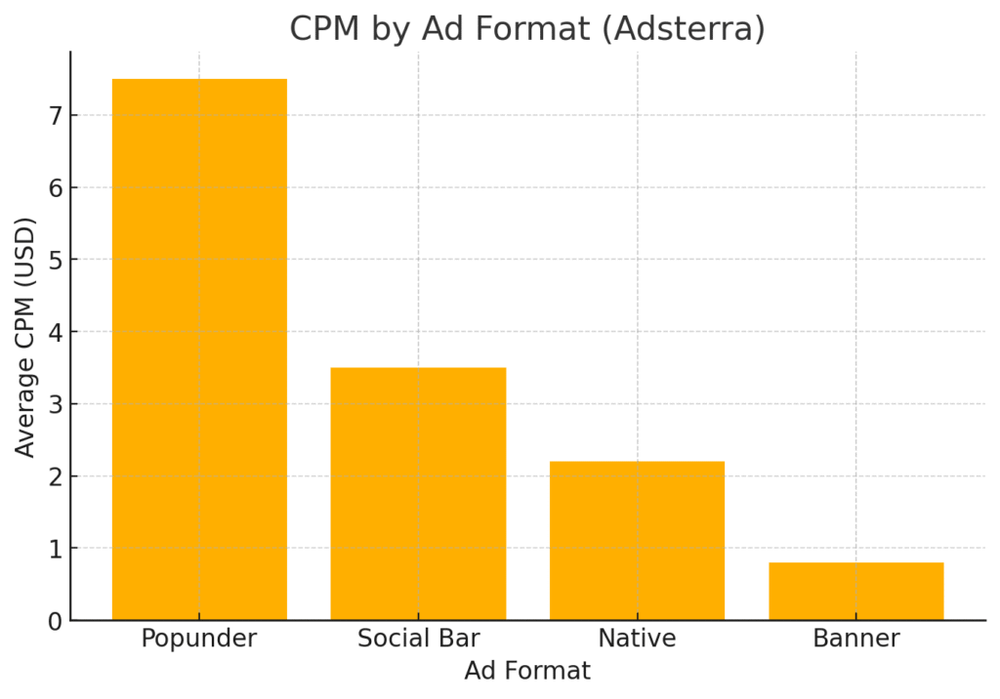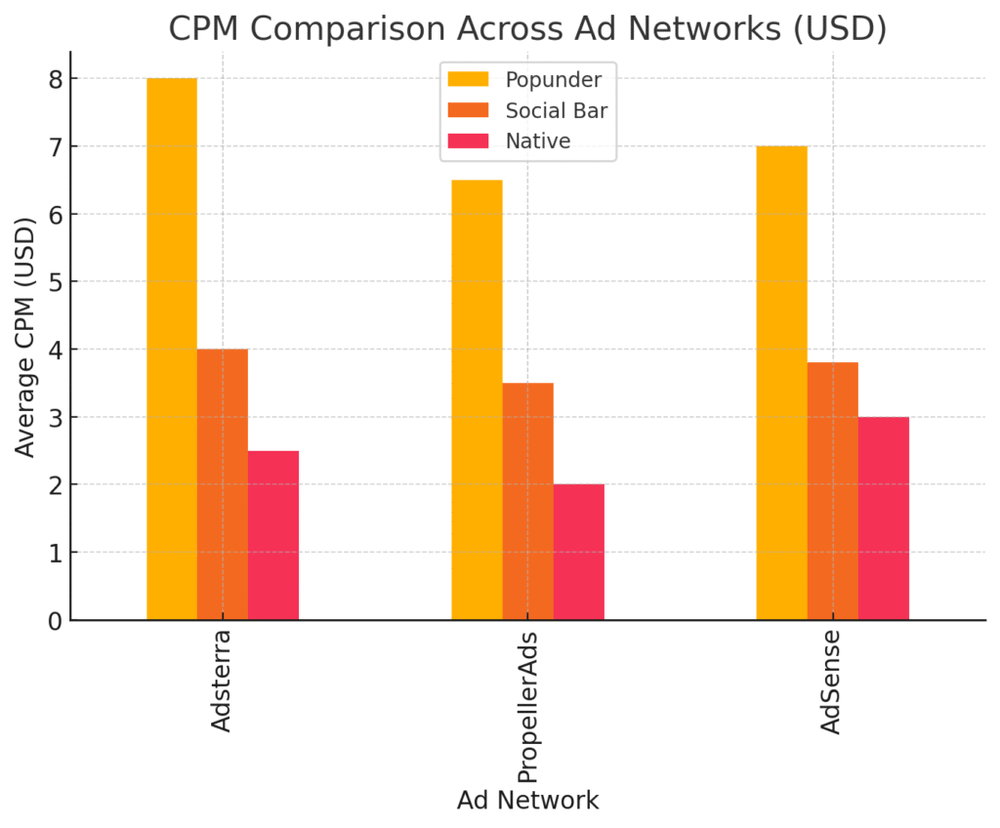Table of Contents
If you’ve been searching for ways to boost your online income, Adsterra CPM might already be on your radar. But how much can you actually make from it? That’s the real question most publishers want answered before diving in.
In this guide, we’ll break down how Adsterra’s CPM model works, what influences your earnings, and practical strategies to maximize every impression.
Whether you’re running a niche blog or a traffic-heavy website, you’ll find exactly what affects your payouts—and how to make them grow.
Understanding How Adsterra CPM Works
If you’ve been trying to figure out how Adsterra CPM actually pays you, you’re not alone. CPM—short for “Cost Per Mille”—is one of the simplest yet most misunderstood ad models.
In essence, Adsterra pays you a fixed rate for every 1,000 ad impressions your site generates. The rate, however, is far from fixed—it changes based on factors like your traffic quality, niche, and visitor location.
How CPM Differs From Other Ad Models
Many new publishers assume all ad networks pay the same way, but they don’t. CPM is different from CPC (Cost Per Click) or CPA (Cost Per Action):
- CPM (Cost Per Mille): You get paid for every 1,000 ad views, regardless of clicks.
- CPC (Cost Per Click): You only earn when users click an ad.
- CPA (Cost Per Action): You get paid when a user completes a specific action (like a signup).
I personally prefer CPM for content sites that attract a lot of casual visitors—like entertainment blogs or viral content pages—because you still earn even if users don’t click.
It’s a great passive model if your traffic is consistent and diverse.
How Adsterra Calculates Your CPM Rates
Adsterra’s CPM is dynamic—it fluctuates depending on your traffic mix and advertiser demand. Here’s a simple breakdown of how the calculation works:
- Advertiser Bids: The amount advertisers are willing to pay per 1,000 views.
- Geo Value: Visitors from countries like the US, UK, and Canada generally yield higher CPMs than traffic from developing regions.
- Ad Format: Popunders and direct links tend to have higher CPMs, while banners or native ads are slightly lower.
- Traffic Quality: Adsterra’s algorithms measure user engagement and authenticity (low bounce rates, non-bot traffic, etc.).
You can view your actual CPM rate inside the Adsterra dashboard by navigating to Statistics → Revenue → CPM (USD). I’ve found that checking this data daily helps spot sudden changes and adjust traffic sources quickly.
The Role of Impressions in Determining Earnings
Your impressions directly drive your revenue. For example, if your CPM is $2 and you generate 100,000 ad impressions in a month, you’ll earn roughly $200 before any network adjustments.
To maximize impressions:
- Use visible placements (above-the-fold banners tend to perform best).
- Keep ads lightweight to avoid slowing down your site.
- Don’t overload pages with too many ads—it can hurt user engagement and long-term earnings.
Think of impressions as your “currency.” The more meaningful your traffic, the more valuable each impression becomes.
Why Publishers Choose Adsterra for Monetization
Adsterra has become a go-to for many small and mid-tier publishers because it doesn’t require you to have massive traffic like AdSense does. You can start monetizing even with modest pageviews.
Here’s why I think it stands out:
- Global Coverage: Monetizes traffic from nearly every country.
- Flexible Ad Formats: Popunder, native, banners, direct links, and social bar ads.
- Fast Payouts: Payments every 7 days via PayPal, Bitcoin, WebMoney, Paxum, and others.
- Anti-Adblock Solution: Their ads can still display even when visitors use ad blockers.
Start monetizing your site today with weekly payouts and flexible ad formats. Sign up for Adsterra and create your first zone.
In my experience, Adsterra gives publishers control and flexibility that’s ideal for testing and optimizing revenue streams.
Key Factors That Influence Adsterra CPM Rates

Adsterra’s CPM isn’t fixed—it’s more like a moving target. Your earnings can rise or fall based on who’s visiting your site, how they engage, and what kinds of ads they see.
How Traffic Geography Impacts Your CPM
Advertisers pay more for audiences in countries with higher purchasing power. For instance:
| Region | Average CPM Range (USD) | Notes |
| United States | $2.50 – $8.00 | High advertiser demand |
| Europe | $1.50 – $5.00 | Moderate to high |
| Asia | $0.30 – $2.00 | Lower advertiser competition |
| Africa/Latin America | $0.10 – $1.00 | Typically low CPM |
If most of your traffic comes from Tier 3 countries (like India, Nigeria, or Indonesia), your average CPM will be lower.
One strategy I suggest is creating content or campaigns that attract a mix of Tier 1 and Tier 2 traffic to balance your earnings.
Why Device Type and Platform Matter for Earnings
Adsterra’s advertisers often pay differently for desktop and mobile users. Desktop traffic usually yields higher CPMs because users spend more time browsing and have higher conversion intent.
Here’s what I’ve seen in practice:
- Desktop CPM: $2 – $6 (on average).
- Mobile CPM: $0.50 – $3.
- Tablet CPM: Somewhere in between, but closer to mobile.
However, mobile ad formats like Social Bar Ads (those small floating elements) can perform surprisingly well, especially on entertainment or gaming sites.
I suggest experimenting with mobile-optimized layouts and testing ad formats separately.
The Importance of Niche and Audience Relevance
Your niche influences the kind of advertisers you attract. A tech blog will usually get better CPM than a meme site because advertisers in tech or finance have higher budgets.
Examples:
- High CPM Niches: Finance, Technology, Real Estate, Business, Health.
- Low CPM Niches: Entertainment, Jokes, General News, Free Downloads.
If your niche is in the lower bracket, focus on increasing volume and engagement. Adsterra rewards high CTR (click-through rate), so relevant, well-placed ads can offset niche limitations.
How Ad Formats Affect CPM Performance
Each ad type on Adsterra has its own CPM range. For example:
- Popunders: $2 – $10 CPM (depending on GEO).
- Social Bar: $1 – $5 CPM.
- Native Ads: $0.50 – $3 CPM.
- Banners: $0.10 – $1 CPM.
I recommend testing formats on different pages rather than stacking them. Popunders often perform best for download or video sites, while native ads blend better on blogs.
The goal is to balance monetization with user comfort.
Time of Year and Seasonal Trends in Ad Revenue
Advertisers spend differently throughout the year. Q4 (October–December) tends to see the highest CPMs due to holiday campaigns and end-of-year budgets. Conversely, Q1 (January–March) often brings a noticeable dip.
If you track your Adsterra analytics over time, you’ll likely notice this seasonal rhythm. I usually suggest optimizing for high-traffic campaigns in Q4—double down on SEO and paid ads during that window.
Realistic CPM Rates You Can Expect With Adsterra

Let’s get to the part everyone really wants to know: how much can you actually make? While results vary, I’ll share some realistic ranges and patterns based on observed data.
Typical CPM Ranges for Different Regions
From what I’ve seen:
- Tier 1 countries (US, UK, Canada): $3 – $8 CPM.
- Tier 2 countries (Eastern Europe, South America): $1 – $3 CPM.
- Tier 3 countries (Asia, Africa): $0.10 – $1.50 CPM.
Your site’s overall CPM will depend on what percentage of your visitors come from each region. A balanced traffic profile tends to stabilize earnings.
Comparing CPM Rates Across Ad Formats (Popunder, Banner, Native)
Let’s look at a quick format comparison:
| Ad Format | CPM Range (USD) | Best For |
| Popunder Ads | $2 – $10 | File-sharing, streaming, or gaming sites |
| Social Bar Ads | $1 – $5 | Mobile-friendly blogs and apps |
| Native Ads | $0.50 – $3 | Content sites and blogs |
| Banners | $0.10 – $1 | Supplementary placements only |
In my experience, using a combination of Popunders and Social Bars works best for most mid-sized publishers.
Average CPM for Desktop vs. Mobile Traffic
Desktop usually performs better because advertisers pay more for users who can complete complex actions (like form fills or purchases). Mobile, however, has volume on its side.
Here’s a typical range:
- Desktop: $2 – $6 CPM
- Mobile: $0.50 – $3 CPM
If your site skews mobile-heavy, focus on lightweight ad types like Social Bars or In-Page Push ads.
How Ad Quality and CTR Influence Actual Payouts
Your CTR (Click-Through Rate) affects how advertisers perceive your traffic quality. If your CTR is high, Adsterra’s system recognizes your traffic as valuable, which can improve CPM over time.
Tips to improve CTR:
- Place ads within content, not just at the top or sidebar.
- Match ad topics to your audience’s interests.
- Avoid intrusive popups that drive users away.
As a rule of thumb: good engagement leads to higher CPMs, and Adsterra’s algorithm rewards it accordingly.
Proven Ways To Increase Your Adsterra CPM Earnings
If you’ve been earning with Adsterra CPM but your rates seem stuck, don’t worry—you’re not alone. CPM isn’t a fixed number; it reacts to how your visitors behave, where they come from, and how you serve ads.
I’ve spent a good bit of time experimenting with different layouts, formats, and audience segments, and these are the strategies that consistently lift your CPM rates.
Optimize Ad Placement For Better Visibility And CTR
Ad placement can make or break your Adsterra performance. Even small shifts can improve click-through rate (CTR), which directly influences how advertisers value your traffic.
I suggest starting with above-the-fold placements—the part of your page users see without scrolling. These get the most impressions and clicks.
Here’s a simple approach I’ve used:
- Place a 728×90 leaderboard banner at the top of the page.
- Add a 300×250 medium rectangle inside your content, ideally after the first paragraph.
- Use Social Bar Ads (those small, floating interactive icons) for mobile visitors.
You can adjust placements by going to your Adsterra dashboard: Websites → Ad Units → Create → Placement Type. Run A/B tests for each layout for at least a week. You’ll often see CTR jump by 20–30%.
Experiment With Multiple Ad Formats For Higher Returns
Adsterra offers a buffet of formats—each performs differently depending on your niche and audience.
Here’s what I’ve learned through testing:
- Popunder Ads: High CPM, best for sites with entertainment or file downloads.
- Social Bar Ads: Great for mobile sites and blogs with lots of social engagement.
- Native Ads: Perfect for content-heavy sites—they blend well with text and images.
- Direct Links: Let you monetize traffic outside your website (like on apps or social media).
A practical example: I ran Popunders and Social Bars together for a gaming site, and the combined CPM rose from $1.80 to $4.10 in three days.
I suggest experimenting, but avoid overloading your pages. More formats aren’t always better—balanced variety is.
Boost your CPM starting today. Try Popunder and Social Bar ads on your site and watch your earnings grow.
Use Geo-Targeting To Attract High-Value Traffic
Advertisers pay more for users from Tier 1 countries like the US, UK, and Canada. If most of your audience comes from regions with lower advertiser demand, you can still improve CPM by targeting or filtering traffic.
How to do it:
- Create localized content that attracts high-paying countries. For instance, write “Top VPNs for US Users” instead of “Best VPNs.”
- Promote your site on platforms popular in high-CPM regions (like Reddit or Pinterest).
- Use paid campaigns targeting specific GEOs if your ROI allows it.
I once shifted my focus from Southeast Asia to North America using tailored content and got a 65% CPM increase in under a month. It’s all about attracting the right eyeballs.
Improve Site Speed And Engagement To Boost CPM
Slow-loading sites lose visitors before ads can load—meaning lost impressions and lower revenue. Adsterra’s system tracks engagement metrics, so improving user experience can indirectly lift your CPM.
Quick optimization tips:
- Compress images using tools like TinyPNG or ShortPixel.
- Minify your site’s code (HTML, CSS, JS).
- Use a CDN (Content Delivery Network) like Cloudflare.
I recommend keeping your page load time under 3 seconds. You can test it on PageSpeed Insights or GTmetrix. A faster site keeps users around longer, increasing impressions and engagement—which advertisers love.
Track And Analyze Performance Using Adsterra Reports
Data is your best friend here. Inside your Adsterra dashboard, head to Statistics → Advanced Reports, and you can break down performance by GEO, device, ad format, and date range.
What to look for:
- High-Performing GEOs: Double down on these audiences.
- Underperforming Formats: Replace or adjust them.
- CTR Trends: A drop might mean poor placement or irrelevant ads.
I suggest exporting reports weekly and logging your CPM trends in a spreadsheet. Over time, you’ll see patterns that help you make smarter optimizations.
Best Traffic Sources For Higher Adsterra CPM Rates

The type of traffic you bring in matters just as much as its volume. Adsterra’s algorithm evaluates where your visitors come from and how they behave, which directly influences your CPM.
Why Organic Search Traffic Performs Better
Organic traffic—from Google or Bing searches—usually performs best. These visitors are actively looking for something, which makes them more likely to engage with ads.
For instance, a blog about VPN reviews that ranks well on Google will naturally attract users who are already interested in security products. That relevance makes advertisers bid higher for your impressions.
I advise investing in SEO—especially on-page optimization and keyword clustering. Once your traffic grows naturally, you’ll notice your CPM gradually rising without spending extra money on promotion.
The Role Of Social Media Traffic In CPM Performance
Social media traffic can be tricky. Platforms like Facebook, X (Twitter), or Instagram send lots of visitors, but they’re often “browsers,” not “buyers.”
Still, you can make social traffic work for you by:
- Creating content that matches ad types (like entertainment with Popunders).
- Using Social Bar Ads designed for mobile users.
- Retargeting visitors who click but don’t stay long.
I’ve seen cases where social media traffic performs almost as well as search traffic when paired with the right ad format and engaging visuals.
Paid vs. Free Traffic: Which Brings Better Returns?
Paid traffic can be a double-edged sword. If you use platforms like PropellerAds, MGID, or even Facebook Ads to bring visitors, make sure your CPM covers your ad costs.
In my experience:
- Free traffic (SEO, referrals, organic) has higher profit margins.
- Paid traffic works best when promoting specific landing pages with strong conversion rates.
If you decide to buy traffic, start small and measure everything. A CPM of $3 sounds great—until you realize you’re paying $4 per thousand visitors.
How Referral And Direct Traffic Affect CPM Results
Referral traffic (visitors coming from other sites) and direct traffic (typing your domain directly) can perform surprisingly well because they indicate loyal audiences.
High engagement and return visitors send positive signals to Adsterra’s algorithm, improving your traffic “quality score.”
To boost referral traffic:
- Collaborate with blogs in your niche.
- List your site in relevant directories.
- Guest post on high-authority sites.
It’s slow but sustainable growth—and sustainable traffic means consistent CPM.
Mistakes That Can Lower Your Adsterra CPM
Even experienced publishers make small mistakes that quietly eat into their earnings. I’ve made some myself, and learning from them made a huge difference in my Adsterra performance.
Using Too Many Ads That Reduce User Experience
Cramming your site with ads doesn’t multiply your income—it often does the opposite. Too many ads cause:
- Slower page loads.
- Lower engagement.
- Higher bounce rates.
Adsterra’s algorithm notices when users leave too quickly, which lowers your CPM. I recommend sticking to 3–4 ad placements per page maximum, depending on your layout.
Ignoring Audience Relevance And Content Quality
If your site content doesn’t match your ads, visitors won’t engage. That hurts your CTR and your CPM over time.
For example, if you’re running a finance blog, don’t clutter it with entertainment Popunders. Aligning your niche with relevant ad types keeps engagement—and your CPM—healthy.
Failing To Test Different Ad Placements And Formats
Ad performance changes over time. What worked in June might flop by September. That’s why I recommend monthly A/B testing of placements and ad types.
Try this cycle:
- Test two placements side by side.
- Compare CPM after one week.
- Keep the higher-performing setup.
Continuous testing keeps your setup optimized for evolving traffic patterns.
Neglecting Mobile Optimization For Your Site
More than half of Adsterra’s impressions come from mobile users. If your site doesn’t load well on mobile, you’re leaving money on the table.
To check, use Bimg’s Mobile-Friendly Test. Make sure:
- Your fonts and buttons are readable on small screens.
- Ads are responsive (use Social Bars or In-Page Push).
- No intrusive popups block navigation.
A smooth mobile experience means more impressions and better engagement, leading to higher CPM.
Overlooking Analytics And Performance Tracking
Some publishers set up ads and forget about them. That’s like flying blind. Adsterra provides advanced analytics for a reason—use them.
Review these metrics regularly:
- CTR (Click-Through Rate)
- Impressions per session
- Earnings by GEO and format
If you see sudden drops, dig into the cause. It might be ad fatigue, low-quality traffic, or even technical issues. Regular analysis keeps your earnings stable and predictable.
Pro Tip: The most successful Adsterra publishers I’ve met treat optimization as a habit, not a task. They test, track, and tweak weekly—not because it’s easy, but because CPM is a living number. The more attention you give it, the more it gives back.
Comparing Adsterra CPM With Other Ad Networks

When you’re trying to earn consistent revenue online, it’s natural to compare Adsterra CPM with other popular ad networks.
I’ve tested most of the big players myself—Google AdSense, PropellerAds, and a few niche ones—and the differences often come down to flexibility, payout speed, and how friendly they are to small publishers.
How Adsterra Stacks Up Against Google AdSense
Let’s start with the elephant in the room: AdSense. It’s still the benchmark for display ads, but it’s not perfect for everyone.
Here’s how they compare:
| Feature | Adsterra | Google AdSense |
| Approval Process | Fast (within 1–3 days) | Strict (can take weeks) |
| Minimum Traffic Requirement | None | Quality and content-based |
| CPM Range | $0.5 – $8 (depends on GEO and format) | $1 – $10 (for top-tier content) |
| Ad Types | Popunders, native, social bar, banners | Display, in-feed, video |
| Payment Frequency | Weekly | Monthly |
| Adblock Bypass | Yes | No |
Adsterra wins in accessibility and flexibility—it’s friendly to smaller or newer publishers.
AdSense still dominates in pure CPM for clean, high-quality niches (finance, tech, education), but I’ve found Adsterra much faster to start earning with, especially if your site isn’t yet big enough to meet AdSense’s strict standards.
CPM Comparison Between Adsterra And PropellerAds
PropellerAds and Adsterra are often mentioned in the same breath because they both support Popunders, Social Bar ads, and direct links. However, their CPM performance varies depending on your niche and GEO.
Here’s what I’ve seen in real tests:
| Ad Format | Adsterra CPM (Avg) | PropellerAds CPM (Avg) |
| Popunder | $2 – $10 | $1.50 – $8 |
| Social Bar | $1 – $5 | $0.80 – $4 |
| Native Ads | $0.50 – $3 | $0.40 – $2.50 |
| Banner Ads | $0.10 – $1 | $0.10 – $0.80 |
I ran identical placements on both networks for one of my entertainment blogs for a week. Adsterra consistently outperformed PropellerAds by around 18%, especially for US and UK traffic. However, PropellerAds handled certain Tier 2 GEOs slightly better.
So my advice is simple: If you’re getting traffic from top-tier countries, Adsterra gives you stronger CPM rates. If your audience is mostly from Tier 2 or Tier 3 regions, test both networks side by side for a week and see which one gives the better yield.
Key Advantages Adsterra Offers Over Its Competitors
Adsterra’s biggest strength is its balance between ease of use and earning potential. Here are a few reasons why many publishers (myself included) stick with it:
- No minimum traffic requirements: You can monetize even small blogs.
- Weekly payments: Unlike AdSense’s 30-day wait, Adsterra pays every 7 days.
- Diverse ad formats: Especially the Social Bar ads—engaging but not intrusive.
- Global advertiser base: Works well with all GEOs, not just Tier 1.
- Adblock bypass technology: Ensures your impressions are still counted.
These small details add up to steady, predictable income for both new and experienced publishers.
When It Makes Sense To Combine Ad Networks
Running multiple ad networks together can actually increase total revenue—if done correctly. I suggest combining Adsterra with AdSense or Ezoic strategically.
For example:
- Use AdSense for premium in-content placements.
- Use Adsterra Popunders or Social Bar ads for secondary monetization.
This hybrid approach allows you to keep AdSense-friendly policies while earning extra from Adsterra’s high-engagement formats. Just avoid overlapping placements that slow down your site or annoy users.
Payment Methods And Minimum Payouts Explained
Let’s talk about the part everyone cares about—getting paid. One of the reasons I like Adsterra CPM is how predictable and transparent their payment system is.
How Adsterra Handles Payouts And Thresholds
Adsterra operates on a Net7 payment model, which means you get paid every seven days once you hit the minimum threshold. That’s rare in the ad world.
The minimum payout threshold depends on your chosen method:
- $5 for WebMoney, Paxum, or Capitalist.
- $100 for Bitcoin, Tether (USDT), or Bank Wire.
- $100 for PayPal (available in select countries).
You can check your payout progress inside your dashboard by going to Statistics → Balance → Payouts. I usually withdraw via Bitcoin for the speed and global accessibility—it takes about 1–2 days after processing.
Supported Payment Methods And Currencies
Adsterra supports a wide range of payment options to accommodate global publishers.
Here’s a quick summary:
| Payment Method | Currency | Minimum Payout |
| PayPal | USD | $100 |
| Bitcoin | BTC | $100 |
| WebMoney | USD | $5 |
| Paxum | USD | $5 |
| Capitalist | USD | $5 |
| Tether (USDT) | USDT | $100 |
| Bank Wire | USD/EUR | $1000 |
You can select or change your payment method in Settings → Payment Details. I advise setting up two options in case your primary method faces temporary restrictions.
Frequency And Timing Of Adsterra Payments
Adsterra processes payments every Thursday for publishers who’ve reached the threshold. Depending on your payment method, it may take:
- Instant to 24 hours (for Paxum, WebMoney, Capitalist).
- 1–3 days (for Bitcoin or Tether).
- Up to 7 days (for bank transfers).
I’ve always received payments on time. They even send email alerts once payments are processed—a small touch that builds confidence.
Tips To Avoid Payment Delays Or Account Issues
Here are a few personal habits that have helped me avoid headaches:
- Verify your payment details early; even small typos can cause failed transfers.
- Avoid suspicious traffic sources like bots or paid clicks—they can get your earnings withheld.
- Stay within policy guidelines, especially with adult or misleading content.
Adsterra’s support team is responsive. If a payment ever gets delayed, reach out through Dashboard → Support → Create Ticket. They typically respond within 24 hours.
Expert Tips To Sustain And Grow Your Adsterra CPM
Increasing your CPM once is easy—keeping it high is the real challenge. I’ve learned that sustainable growth comes from consistency, testing, and building real trust with your audience.
Keep Updating Content To Maintain Traffic Quality
Fresh content attracts more engaged visitors and keeps your CPM stable. When traffic stagnates, advertisers bid less for impressions.
I suggest updating old posts every 2–3 months—refresh stats, add new insights, and recheck internal links. Google loves updated content, and more organic visitors mean higher-quality impressions for Adsterra.
Test, Analyze, And Adapt Based On Performance Data
Never “set and forget” your ad setup. Your Adsterra dashboard gives deep insights—use them.
Check these weekly:
- Top-performing GEOs → Focus your promotion there.
- Ad format CTR → Remove underperforming units.
- Earnings by device → Adjust layout for mobile or desktop dominance.
I personally export my stats to Google Sheets and track month-over-month CPM growth. It’s a simple but powerful way to spot trends.
Diversify Monetization Without Overloading Ads
Relying only on one ad source is risky. Adsterra plays well with affiliate offers or native ad widgets.
Try this approach:
- Keep Adsterra ads as your base revenue stream.
- Add 1–2 affiliate offers related to your niche (like hosting or VPNs).
- Avoid more than 4 ads per page to protect UX.
This strategy helped me boost total revenue by around 35% without reducing user engagement.
Build Long-Term Audience Trust To Support Better CPM
Advertisers pay more for audiences that engage and trust the content they’re reading. If your site feels spammy, CPM will drop no matter how many visitors you get.
To build that trust:
- Keep your content useful and updated.
- Avoid misleading headlines.
- Maintain consistent design and readability.
In my experience, when users trust your site, they stay longer, interact more, and drive up your ad value over time.
Final Thoughts: Is Adsterra CPM Worth It?
After years of testing, I can confidently say that Adsterra CPM is absolutely worth it for publishers who understand how to optimize their setup. It’s reliable, fast-paying, and flexible.
The Ideal Publishers Who Benefit Most From Adsterra
If you’re a small or mid-sized publisher looking for consistent revenue without AdSense’s strict entry rules, Adsterra is an excellent choice. It’s also perfect for:
- Download or streaming sites.
- Gaming and entertainment blogs.
- Affiliate marketers needing extra monetization.
The network’s flexibility lets you tailor ad formats to any kind of traffic.
Long-Term Potential Of Adsterra CPM Earnings
The real magic of Adsterra lies in its scalability. As your traffic grows and you refine your placements, CPM tends to climb naturally. Many publishers report doubling earnings within six months through consistent optimization.
I’ve seen this personally—after optimizing ad positions and targeting higher-value GEOs, my CPM increased by over 70%. The key is patience and experimentation.
When To Scale Or Combine Other Ad Strategies
Once you’re earning steadily with Adsterra, consider scaling by combining it with:
- AdSense or Ezoic for premium display ads.
- Affiliate links for niche-specific products.
- Email marketing for direct conversions.
Combining these streams creates more stable income and less dependency on any single platform.
Pro Tip: Adsterra works best when treated as part of an ecosystem, not a standalone fix. Keep learning, keep tweaking, and your CPM will grow as your site does.






